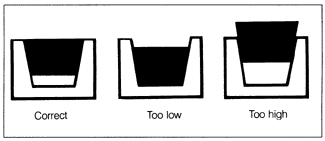Replacing V-BeltsTo reduce the chance of V-belt failure while driving, replacement of the belts every four years is recommended. Loosen the mounting bolts and adjust until the belt tension is very loose, then remove the belt by slipping it over the pulleys. In some cases it may be necessary to remove one V-belt to replace another. Cross section and length determine belt size. Use the old belt for comparison, or make sure that the new belt fits into the pulley groove as shown in Fig. 6-5.

With the belt off, clean the pulleys using a suitable solvent. Inspect the pulleys for wear or damage which may cause early failure of the new belt. This is also a good opportunity to inspect the belt-driven accessory, checking for bearing wear and excess play, for example. When installing the new belt, gently pry it over the pulleys. Too much force may damage the belt. Tension the belt(s), run the engine for a few minutes (at least 1500 rpm), then recheck the belt tension. |